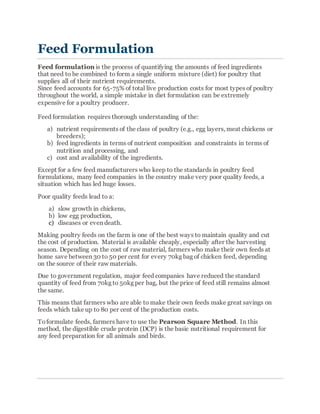
Feed formulation
- 1. Feed Formulation Feed formulation is the process of quantifying the amounts of feed ingredients that need to be combined to form a single uniform mixture (diet) for poultry that supplies all of their nutrient requirements. Since feed accounts for 65-75% of total live production costs for most types of poultry throughout the world, a simple mistake in diet formulation can be extremely expensive for a poultry producer. Feed formulation requires thorough understanding of the: a) nutrient requirements of the class of poultry (e.g., egg layers, meat chickens or breeders); b) feed ingredients in terms of nutrient composition and constraints in terms of nutrition and processing, and c) cost and availability of the ingredients. Except for a few feed manufacturers who keep to the standards in poultry feed formulations, many feed companies in the country make very poor quality feeds, a situation which has led huge losses. Poor quality feeds lead to a: a) slow growth in chickens, b) low egg production, c) diseases or even death. Making poultry feeds on the farm is one of the best ways to maintain quality and cut the cost of production. Material is available cheaply, especially after the harvesting season. Depending on the cost of raw material, farmers who make their own feeds at home save between 30 to 50 per cent for every 70kg bag of chicken feed, depending on the source of their raw materials. Due to government regulation, major feed companies have reduced the standard quantity of feed from 70kg to 50kg per bag, but the price of feed still remains almost the same. This means that farmers who are able to make their own feeds make great savings on feeds which take up to 80 per cent of the production costs. Toformulate feeds, farmers have to use the Pearson Square Method. In this method, the digestible crude protein (DCP) is the basic nutritional requirement for any feed preparation for all animals and birds.
- 2. Pearson Square Method The Pearson Square Method of balancing rations is a simple procedure that has been used for many years. It is of greatest value when only two ingredients are to be mixed. In taking a close look at the square, several numbers are in and around the square. Probably one of the more important numbers is the number that appears in the middle of the square. This number represents the nutritional requirement of an animal for a specific nutrient. It may be crude protein or TDN, amino acids, minerals or vitamins. In order to make the square work consistently, there are three very important considerations: 1. The value in the middle of the square must be intermediate between the two values that are used on the left side of the square. For example, the 14 percent crude protein requirement has to be intermediate between the soybean meal that has 45 percent crude protein or the corn that has 10 percent crude protein. If barley is used that has 12 percent crude protein and corn that has 10 percent crude protein, the square calculation method will not work because the 14 percent is outside the range of the values on the left side of the square. 2. Disregard any negative numbers that are generated on the right side of the square. Be concerned only with the numerical differences between the nutrient requirement and the ingredient nutrient values. 3. Subtract the nutrient value from the nutritional requirement on the diagonal and arrive at a numerical value entitled parts. By summing those parts and dividing by the total, you can determine the percent of the ration that each ingredient should represent in order to provide a specific nutrient level. Always subtract on the diagonal within the square in order to determine parts. Always double check calculations to make sure that you did not have a mathematical error. It also is very important to work on a uniform basis. Use a 100-percent dry-matter basis for nutrient composition of ingredients and requirements and then convert to an as-fed basis after the formulation is calculated.
- 3. Corn represents (31.0 / 35.00) x 100 of the ration, or 88.57 percent. Soybean meal represents (4.0 / 35.00) x 100 of the ration, or 11.43 percent. Check of the calculation: 88.57 lb corn x 10.0% CP = 8.86 11.43 lb SBM x 45.0% CP = 5.14 100.00 lb mixture contains = 14.00 lb CP, or 14 percent. Example Formulate 450 lbs of a 28% CP ration using Cottonseed Meal (49% CP) and Millet (3% CP). CSM 49% CP 25 parts CSM Millet 3% CP 21 parts Millet 46 Total Parts How many pounds of cottonseed meal will be used? (25 parts cottonseed meal / 46 total parts) x 100= 0.54 parts cottonseed meal 0.54 parts cottonseed meal x 450 lb ration = 243 lbs cottonseed meal needed How many pounds of millet will be used? (21 parts millet / 46 total parts) x 100 = 0.46 parts millet 0.46 parts millet x 450 lb ration = 207 lbs millet needed Double check your answer: 243 lbs cottonseed meal + 207 lbs millet needed = 450 lbs ration 28%